
Sicily is the largest and most populous island in the Mediterranean Sea and one of the 20 regions of Italy with the Strait of Messina dividing it from the region of Calabria in Southern Italy. It is one of the five Italian autonomous regions and is officially referred to as Regione Siciliana. The region has 4.8 million inhabitants. Its capital city is Palermo.

Frederick III, called the Simple, was King of Sicily from 1355 to 1377. He was the second son of Peter II of Sicily and Elisabeth of Carinthia. He succeeded his brother Louis. The documents of his era call him the "infante Frederick, ruler of the kingdom of Sicily", without any regnal number.
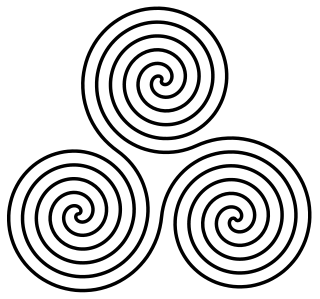
A triskelion or triskeles is an ancient motif consisting of a triple spiral exhibiting rotational symmetry or other patterns in triplicate that emanate from a common center. The spiral design can be based on interlocking Archimedean spirals, or represent three bent human legs. It is found in artifacts of the European Neolithic and Bronze Age with continuation into the Iron Age especially in the context of the La Tène culture and related Celtic traditions. The actual triskeles symbol of three human legs is found especially in Greek antiquity, beginning in archaic pottery and continued in coinage of the classical period.

The flag of the Isle of Man or flag of Mann is a triskelion, composed of three armoured legs with golden spurs, upon a red background. It has been the official flag of the Isle of Mann since 1 December 1932 and is based on the Manx coat of arms, which dates back to the 13th century.

The Kingdom of Sicily was a state that existed in the south of the Italian Peninsula and for a time the region of Ifriqiya from its founding by Roger II of Sicily in 1130 until 1816. It was a successor state of the County of Sicily, which had been founded in 1071 during the Norman conquest of the southern peninsula. The island was divided into three regions: Val di Mazara, Val Demone and Val di Noto.
Three-finger salute may refer to:

Louis the Child was King of Sicily from 15 September 1342 until his death. He was a minor upon his succession, and was under a regency until 1354. His actual rule was short, for he died in an outbreak of plague the next year. His reign was marked by civil war.
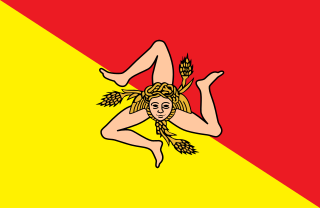
The flag of Sicily shows a triskeles symbol, and at its center a Gorgoneion and a pair of wings and three wheat ears.
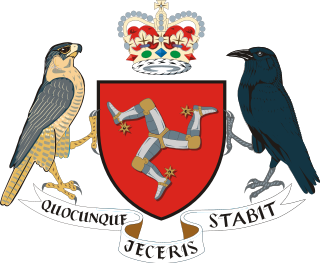
The Coat of Arms of the Isle of Man, blazoned Gules three legs in armour flexed at the knee and conjoined at the thigh, all proper, garnished and spurred or, dates from the late 13th century. The present version dates from 12 July 1996. As the Isle of Man is a Crown dependency and the present Lord of Man is King Charles III of the United Kingdom, the arms are more accurately described as the Arms of His Majesty in right of the Isle of Man. The origin of the triskeles is obscure, but it appears to stem from the Scottish takeover of the island in 1265. The heraldic supporters are birds associated with the island, whilst the motto first appears on record in the 17th century.
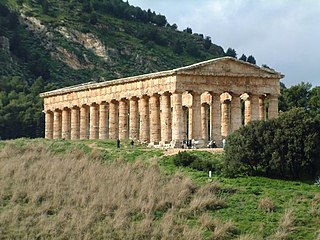
The history of Sicily has been influenced by numerous ethnic groups. It has seen Sicily controlled by powers – Phoenician and Carthaginian, Greek, Roman, Vandal and Ostrogoth, Byzantine Greek, Arab, Norman, Aragonese, Spanish, Austrians, British – but also experiencing important periods of independence, as under the indigenous Sicanians, Elymians, Sicels, the greek-siceliotes, and later as County of Sicily, and Kingdom of Sicily. The Kingdom was founded in 1130 by Roger II, belonging to the Siculo-Norman family of Hauteville. During this period, Sicily was prosperous and politically powerful, becoming one of the wealthiest states in all of Europe. As a result of the dynastic succession, then, the Kingdom passed into the hands of the Hohenstaufen. At the end of the 13th century, with the War of the Sicilian Vespers between the crowns of Anjou and Aragon, the island passed to the latter. In the following centuries the Kingdom entered into the personal union with the Spaniard and Bourbon crowns, while preserving effective independence until 1816. Sicily was merged with the Kingdom of Italy in 1861. Although today an Autonomous Region, with special statute, of the Republic of Italy, it has its own distinct culture.

Constance II of Sicily was Queen consort of Aragon as the wife of Peter III of Aragon and a pretender to the Kingdom of Sicily from 1268 to 1285. She was the only daughter of Manfred of Sicily and his first wife, Beatrice of Savoy.
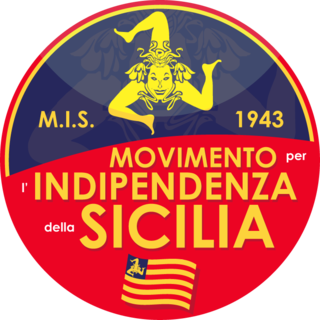
The Movement for the Independence of Sicily was a separatist cultural movement with the goal of obtaining the independence of Sicily from Italy. It had its roots in the Movement for the Independence of Sicily, which was founded by Andrea Finocchiaro Aprile in 1943.

Beatrice of Rethel was a French noblewoman and Queen of Sicily as the third wife of Roger II.
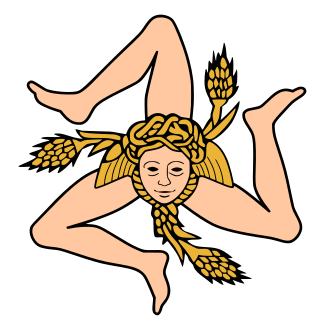
The Movement for the Independence of Sicily was a separatist Sicilian political party originally active in Sicily from 1943 to 1951. Its best electoral result was in 1947, when it won 8.8% of the votes in the Sicilian regional election and had nine regional deputies elected.

Giuseppe Castellano was an Italian general who negotiated the Armistice between Italy and Allied armed forces on September 8, 1943.

Sicilian nationalism, or Sicilianism, is a movement in the autonomous Italian region of Sicily, as well as the Sicilian diaspora, which seeks greater autonomy or outright independence from Italy, and/or promotes further inclusion of the Sicilian identity, culture, history, and linguistic variety.

Andrea Finocchiaro Aprile was an Italian politician.
The Treaty of Villeneuve (1372) was the definitive agreement that ended the dispute between the House of Anjou and the House of Barcelona over the Kingdom of Sicily that began ninety years earlier in 1282. Its final form was approved by Pope Gregory XI in a bull issued at Villeneuve-lès-Avignon on 20 August 1372, and it was ratified by Queen Joan I of Naples and King Frederick IV of Sicily on 31 March 1373 at Aversa, in Joan's kingdom, in front of the papal legate, Jean de Réveillon, Bishop of Sarlat.
Three finger may refer to:















